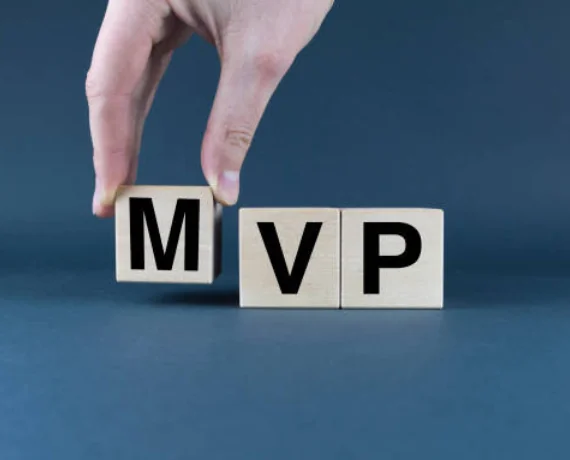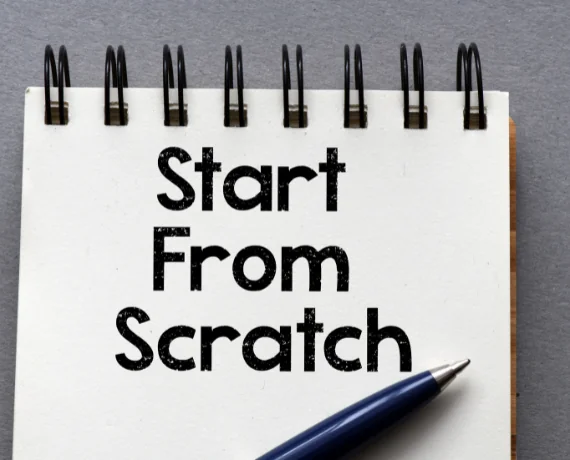Table of Content
- Understanding the MVP Development Process
- What’s the Difference Between MVP and Full-Scale Product
- When You Can Not Scale MVP?
- 5 Steps of Scaling From an MVP to a Full-Fledged Product
- Developing a Minimum Lovable Product (MLP) for Market Success
- What Criteria Should I Meet Before Scaling an MVP
- Questions to answer before scaling MVP
- Common Problems Faced When You Scale an MVP
- Conclusion
Do you want to develop your product?
Book a callTo create a successful product, begin with a Minimum Viable Product (MVP). An MVP assists in validating concepts, gathering user input, and making required changes prior to scaling. If you’re not sure where to begin, here’s some guidance on how to build an MVP.
But what comes after MVP? The next stage is to grow your MVP, which will convert it into a full-size product. However, scaling involves more than simply adding features; it is also about ensuring that the product can withstand expansion and growing demand. In this article, we’ll discuss the process of MVP scale and what comes after that in your product’s journey.
Understanding the MVP Development Process
The Minimum Viable Product (MVP) development process is a crucial stage in the product development lifecycle. It involves creating a product with only the most essential features to test the market, gather feedback, and validate assumptions. The MVP development process is iterative, requiring continuous improvement and refinement based on user feedback and market trends. By focusing on the core functionalities, you can quickly launch your product, gather valuable insights, and make data-driven decisions for future MVP development. This approach not only minimizes risk but also ensures that your product evolves in alignment with user needs and market demands.
What Comes After MVP Product Creation?
After creating an MVP, the next step is to refine and improve the product based on user feedback and market trends. This involves analyzing user data, gathering feedback, and prioritizing features for future development. The goal is to create a Minimum Marketable Product (MMP) that meets the needs of the target audience and is ready for launch. By focusing on the most impactful features and addressing any pain points identified during the MVP phase, you can ensure that your product is well-received in the market. This stage is critical for transforming your initial concept into a robust, market-ready solution.
Start Small with Minimal Features
Starting small with minimal features is a key principle of the MVP development process. This approach allows developers to test the market, gather feedback, and validate assumptions without investing too much time and resources. By starting small, developers can also reduce the risk of failure and improve the chances of success. This lean methodology ensures that only the most critical features are developed initially, allowing for quick iterations and adjustments based on user feedback. As the product gains traction and user needs become clearer, additional features can be incrementally added, ensuring a more focused and user-centric development process.
What’s the Difference MVP and Full-Scale Product
Clearly, distinguishing a minimum viable product (MVP) from a full-scale product is critical when creating a digital product. An MVP focuses on quickly proving an idea by delivering minimal capabilities. A full-scale product, on the other hand, is the final one designed for a wide market and has all the stated criteria.
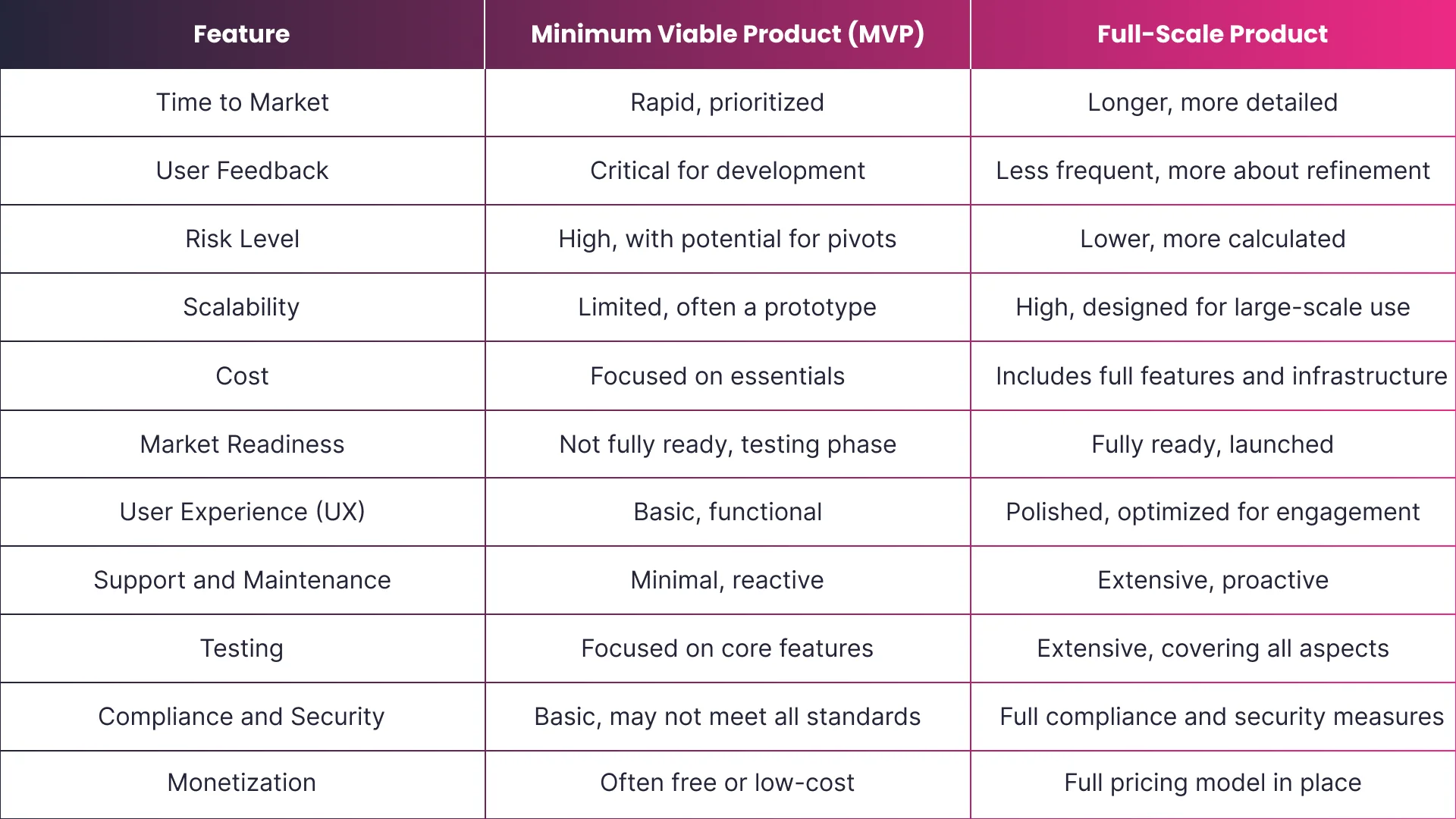
Understanding these characteristics is key for effectively scaling an MVP to full product. Knowing what comes after minimum viable product ensures a smooth transition and greater market fit.
When You Can Not Scale MVP?
Scaling an MVP isn’t always straightforward. Many elements can inhibit effective scaling, hence it is important to evaluate readiness before growing and to know what comes after MVP.
1. Technical Limitations
Your MVP’s technology or design might not be able to meet rising demand. Bottlenecks can be produced by poor infrastructure, insufficient database capacity, or inefficient coding. Scaling might cause system issues, for example, if the backend of the program cannot handle more users or transactions. Before scalability, these elements must be optimally developed, and the question is how to choose a technology stack for my product.
2. Lack of Product-Market Fit
Should your MVP fall short of your target market’s needs, growing it will not solve the underlying reason. A product that does not appeal to consumers is probably going to fail, even with extra features. Before growing, it is imperative to compile and act upon customer feedback to guarantee the product satisfies market expectations. Knowing what comes after MVP helps you solve problems before they get more serious.
3. Market Changes
The change in the market environment affects the relevancy of your product. Your MVP may become less competitive depending on new rivals, changing customer tastes, or emerging technology. Consistent market research can help you ascertain whether your product is still suited for scaling.
4. Regulatory Hurdles
Changes in regulations or new laws can obstruct the scaling process. For example, data protection laws or industry-specific regulations might require substantial adjustments to your MVP. Ensuring compliance before scaling is critical to avoid legal complications. These considerations are especially important in what comes after MVP in agile development processes.
5. Profitability Challenges
Scaling is pointless if your product’s economics don’t work. Negative profit margins, poor lifetime value, or high client acquisition expenses might make scaling financially unworkable. Before trying to grow, you must polish your business strategy and guarantee profitability. Knowing what is next after MVP in terms of financial planning is a key to long-term success.
5 Steps of Scaling From an MVP to a Full-Fledged Product
Bringing your MVP to the next level calls for both meticulous preparation and execution. The following five simple actions will help to guarantee a seamless transfer.
1. Gather User Feedback
After introducing an MVP, user comments are absolutely vital, as they enable you to pinpoint areas that require improvements and those that go right. Dealing with early adopters helps you to understand consumer preferences and problems. Perfecting the product before scaling depends on this knowledge. Learning what comes after MVP starts with listening to your users and using their feedback to inform the future MVP development process.
2. Prioritize Features
Not every ability develops similarly. It is essential to rate the features in line of value for your consumers once comments have been gathered. Emphasize those who manage user needs and complement the goals of your business. Knowing how to scale an MVP application involves making tough decisions on what to develop first.
3. Build a Scalable Infrastructure for Future Growth
A fully developed product is mostly dependent on a strong infrastructure. Make sure your stack of technologies can manage the growing data load and traffic. This might involve upgrading servers, optimizing databases, or integrating cloud solutions. As you scale, think ahead about what comes after MVP MMR (Minimum Marketable Release) to ensure your infrastructure supports future growth.
4. Refine the Software Development Process
Scaling aims to improve or speed up your development process as much as it does feature-adding. Apply agile techniques, streamline testing, and make sure your staff supports the scaling objectives. Continuous improvement in your process ensures that you can handle the complexities of a full product. What comes after MVP product development depends on this clarity.
5. Continuous Monitoring and Iteration after Scaling the MVP
The task doesn’t cease even after scaling. Essential is ongoing observation of consumer behavior, system performance, and market developments. Iteratively improve using this information. Frequent updates and improvements assist to sustain consumer pleasure and product relevancy. Knowing what comes after an MVP includes ongoing refinement and adaptation.
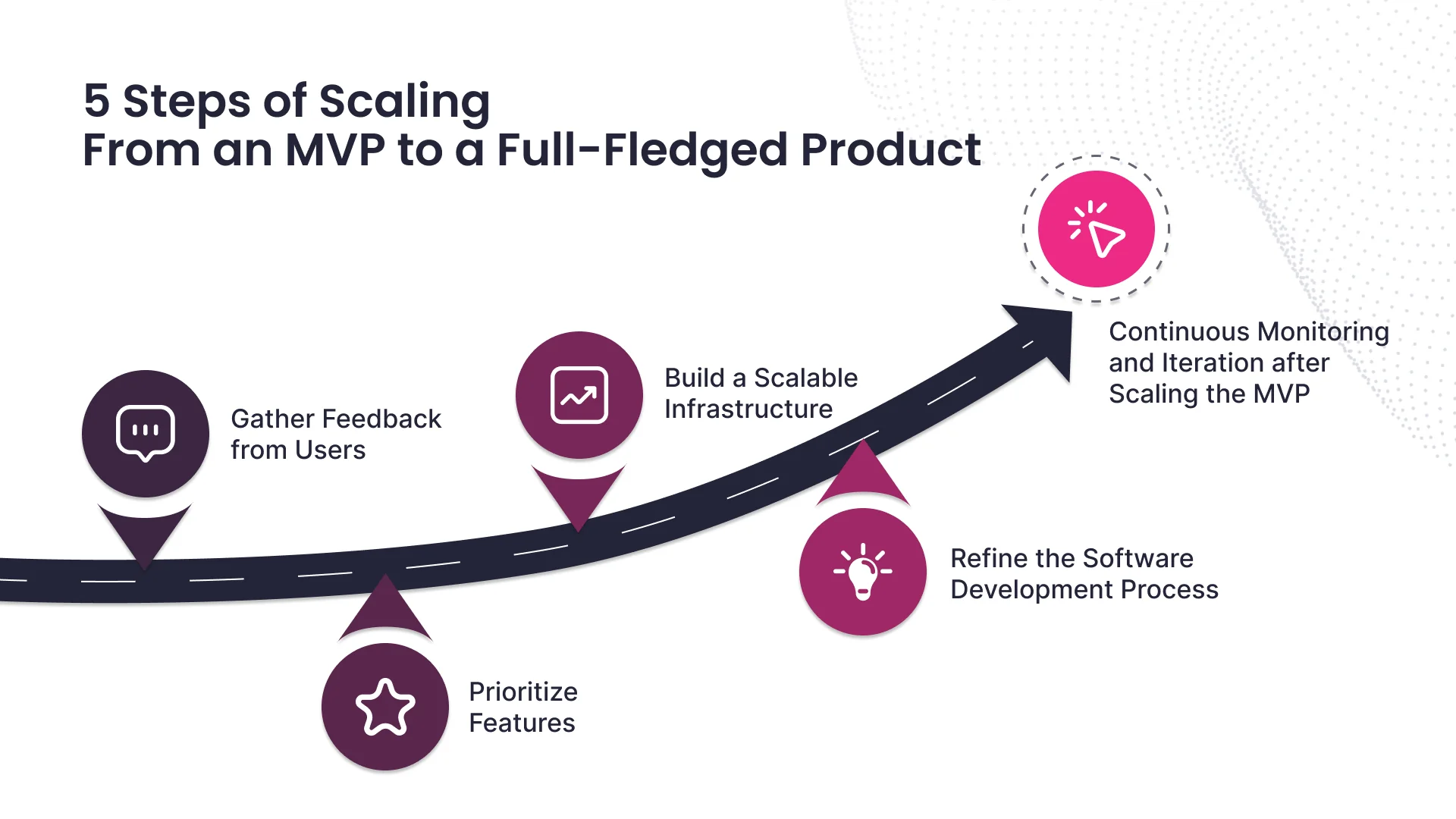
These steps will help you to properly move from an MVP to a full-scale product, therefore guaranteeing long-term market success.
Developing a Minimum Lovable Product (MLP) for Market Success
A Minimum Lovable Product (MLP) is a product that is not only functional but also delightful and enjoyable to use. Developing an MLP requires a deep understanding of the target audience, their needs, and their pain points. It also requires a focus on user experience, design, and continuous improvement. By creating a product that users love, you can foster a loyal customer base and drive long-term success. An MLP goes beyond basic functionality to create an emotional connection with users, making them more likely to adopt and advocate for your product.
What is a Minimum Lovable Product (MLP)?
A Minimum Lovable Product (MLP) is a product that is designed to delight and engage users. It is a product that is not only functional but also enjoyable to use, providing a unique and memorable experience for the user. An MLP is designed to create an emotional connection with the user, which is a key factor in driving user adoption and retention. By focusing on the elements that make a product lovable, such as intuitive design, seamless user experience, and addressing core user needs, you can ensure that your product stands out in the market and fosters a strong, loyal user base.
What Criteria Should I Meet Before Scaling an MVP
Before raising an MVP, consider three key signs of your product’s readiness. These indications aid measure the success of an MVP and ensure that your MVP is robust enough to handle increased demand and seamlessly transition to a full-scale product. In the table below, let’s review MVP success criteria:
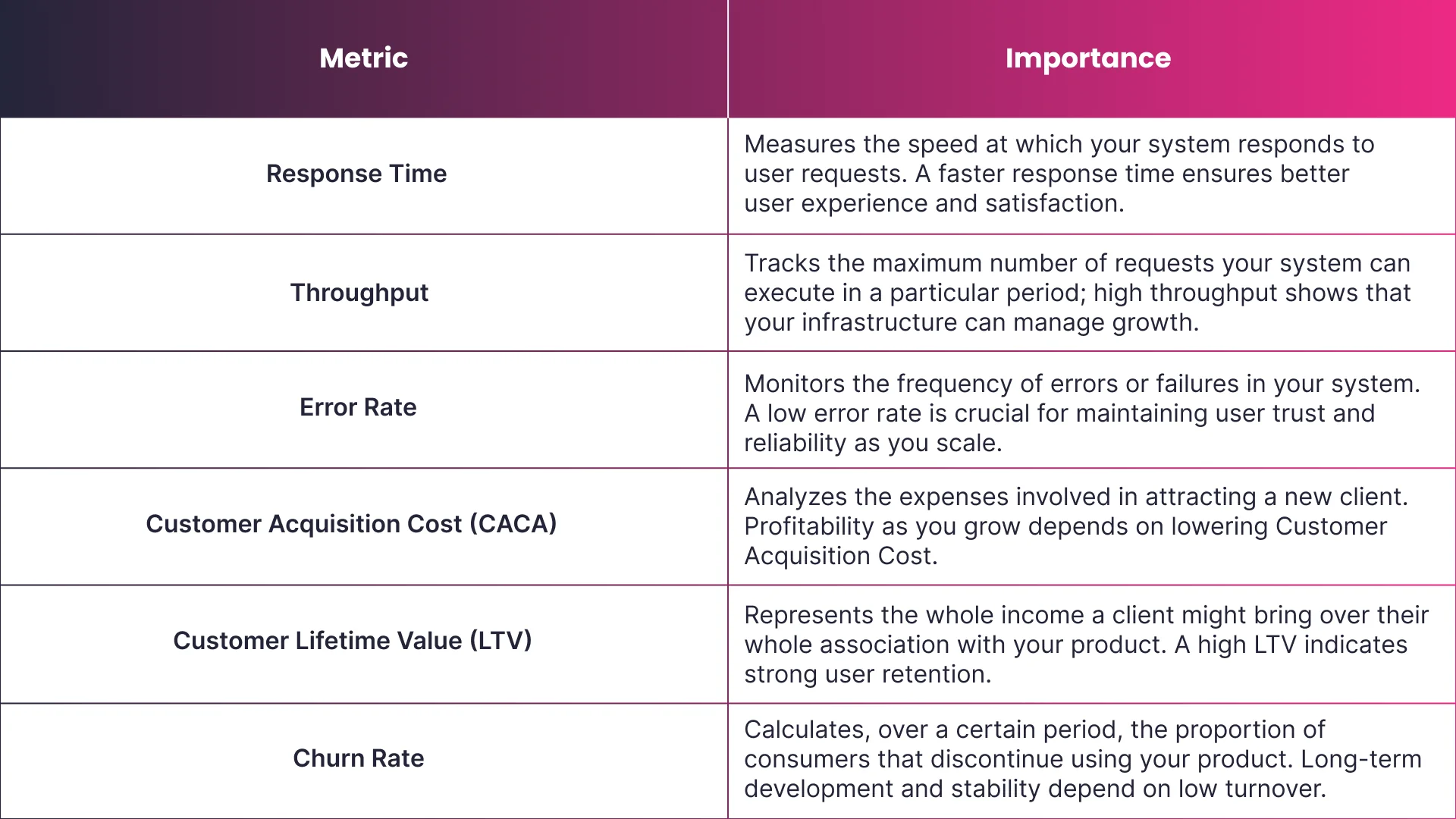
These metrics are essential components of MVP success metrics and are vital in setting the criteria. By frequently reviewing these characteristics, you can better understand how to measure MVP success and guarantee your product is ready to grow.
Looking for a tech partner for your startup?
Questions to answer before scaling MVP
- Have you mostly fulfilled your objectives?
- Ready for more traffic? Is your infrastructure good?
- Is there an obvious match between products and markets?
- Have you thought through how you may grow your staff?
- Have you had the required scaling funds?
- Have you found possible hazards and corresponding solutions?
- Are your systems of customer support and service scalable?
- Has your feature development’s clear road map been laid out?
- Do you have any compliance or legal concerns to handle?
- How are you going to keep users interested?
These considerations are vital for determining how to scale an MVP app successfully.
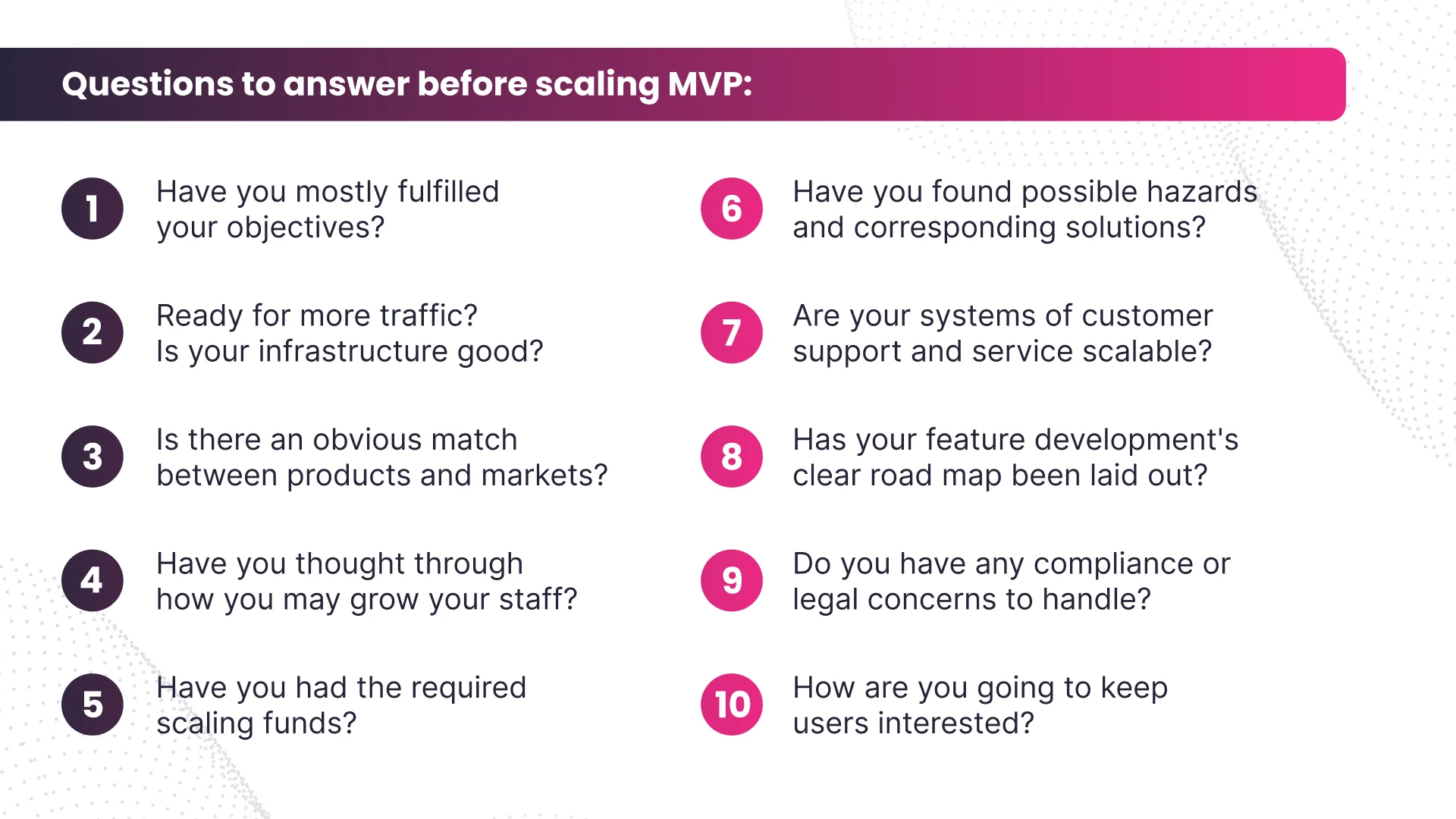
Common Problems Faced When You Scale an MVP
Scaling an MVP is a critical phase where many challenges arise. These problems can hinder the transition from an MVP to a full product if not addressed properly.
1. Technical Infrastructure
One of the biggest mistakes when developing an MVP is underestimating the technical infrastructure needed for scaling. With a small user base, an MVP could perform effectively; yet, scaling calls for strong infrastructure able to manage more traffic and load. Should the system not be designed with scalability in mind, performance constraints and downtime might follow when more customers start using the product. This is especially true in what comes after MVP when your product is gaining traction.
2. Scalability of Database
Scalability of the database is another frequently seen problem. Often during the MVP phase, the emphasis is on expeditious product release, which might result in database architectural shortcuts. But when the user base expands, these shortcuts might seriously create issues. Poor database design can lead to slow query responses and even data loss, making it one of the mistakes to avoid with MVP. Ensuring that your database can scale efficiently is crucial in converting MVP to full product status.
3. User Experience
Maintaining a consistent and good user experience is harder as you grow. Mistakes during MVP development often involve ignoring user experience elements that, at early stages, seem not important. On the other hand, a bad user experience could cause more product scale-related turnover. It is critical to consistently improve the user experience in order to fulfill the expectations of a bigger and more diversified audience, particularly what comes after MVP products.
4. Team Scalability
Scaling a product often requires scaling the team as well. Mistakes when building an MVP include not budgeting for the team growth required to support a developing product. Overworked employees, inadequate communication, and finally declining product quality can all follow from this. Success depends on your team’s structure being scalable and having the correct capabilities in place. This is especially crucial in what comes after MVP in agile techniques, where iteration and ongoing development rule.
5. Integration and Interoperability
Ultimately, connecting your product with other systems and guaranteeing compatibility gets more difficult as it grows. MVP mistakes usually result from ignoring the necessity of flawless interaction with outside goods or services. The product needs to function properly inside a bigger ecosystem as you grow, which calls for careful design and implementation. Looking to convert MVP to full product, this connection is really vital.
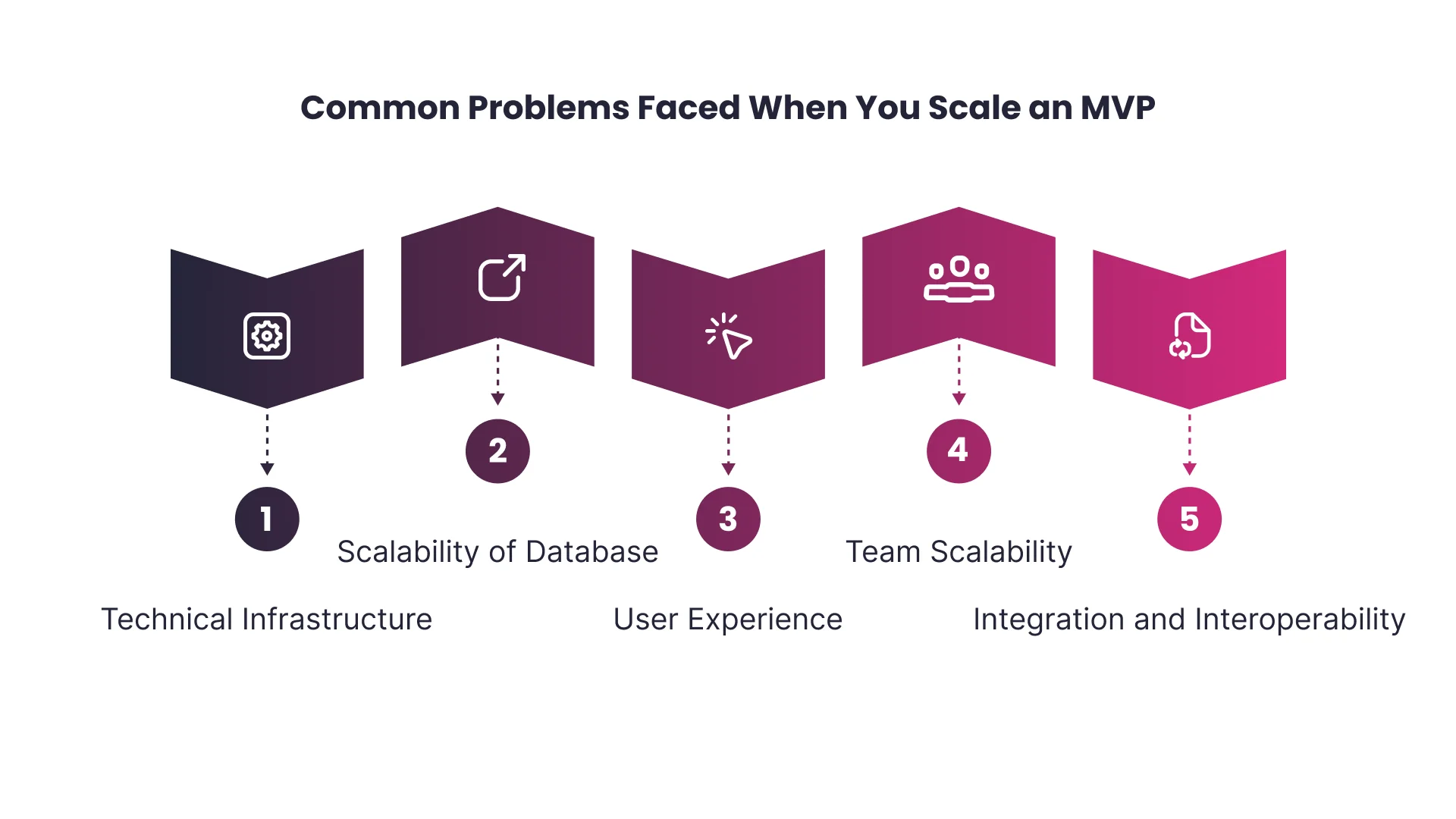
If you want great help overcoming these obstacles, think about working with MVP software development services. Their knowledge will help you avoid typical mistakes and guarantee excellent product scalability.
Let’s talk about your project? Feel free to ask any additional questions you might have. Our experts will be glad to assist you.

A key stage in the evolution of a product is scaling an MVP. To succeed, it requires careful preparation and intelligent decisions. Grasping what comes after MVP is vital for steering these efforts, especially as you enter the post MVP stage, where the emphasis transitions from validation to expansion.
As you transition, it’s important to carefully consider “what comes after MVP in agile?” during your development processes. This means constant improvement to ensure that your product adapts to consumer needs and market expectations. Dealing with the common problems and making smart decisions will help you to effectively convert your MVP into a complete product capable of maintaining long-term success in a competitive market.
Create a team equipped for quick scalability with knowledge and expertise. Hiring professionals in development, operations, and marketing will help you concentrate on what comes after MVP. Guarantee effective communication and agile techniques.
Select a technological stack backed by a vibrant development community that is scalable, and adaptable. This will help you navigate what comes after MVP. Consider future growth and integration needs.
Make sure your infrastructure can manage rising traffic, is scalable and safe. This is crucial for managing what comes after MVP product expansion. Invest in cloud solutions and database optimization.
Based on user comments and their effect on user experience, prioritize features; then, pay close attention to what comes after MVP to guarantee the product satisfies market needs. Start with qualities that most contribute value.
When you have a solid user base and have confirmed the product-market fit, you know the ideal moment to scale an MVP. This ensures you are ready for what comes after MVP. Make sure your infrastructure can handle growth.
Questions? Answers!
How do I build a high-performing team for scaling?
Create a team equipped for quick scalability with knowledge and expertise. Hiring professionals in development, operations, and marketing will help you concentrate on what comes after MVP. Guarantee effective communication and agile techniques.
How do I choose the right technology stack for scaling?
Select a technological stack backed by a vibrant development community that is scalable, and adaptable. This will help you navigate what comes after MVP. Consider future growth and integration needs.
What infrastructure considerations should I make when scaling an MVP?
Make sure your infrastructure can manage rising traffic, is scalable and safe. This is crucial for managing what comes after MVP product expansion. Invest in cloud solutions and database optimization.
How do I determine which features to prioritize for scaling?
Based on user comments and their effect on user experience, prioritize features; then, pay close attention to what comes after MVP to guarantee the product satisfies market needs. Start with qualities that most contribute value.
When is the right time to scale an MVP?
When you have a solid user base and have confirmed the product-market fit, you know the ideal moment to scale an MVP. This ensures you are ready for what comes after MVP. Make sure your infrastructure can handle growth.

